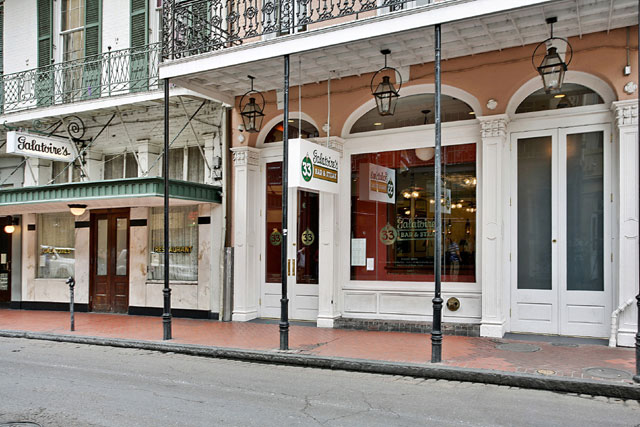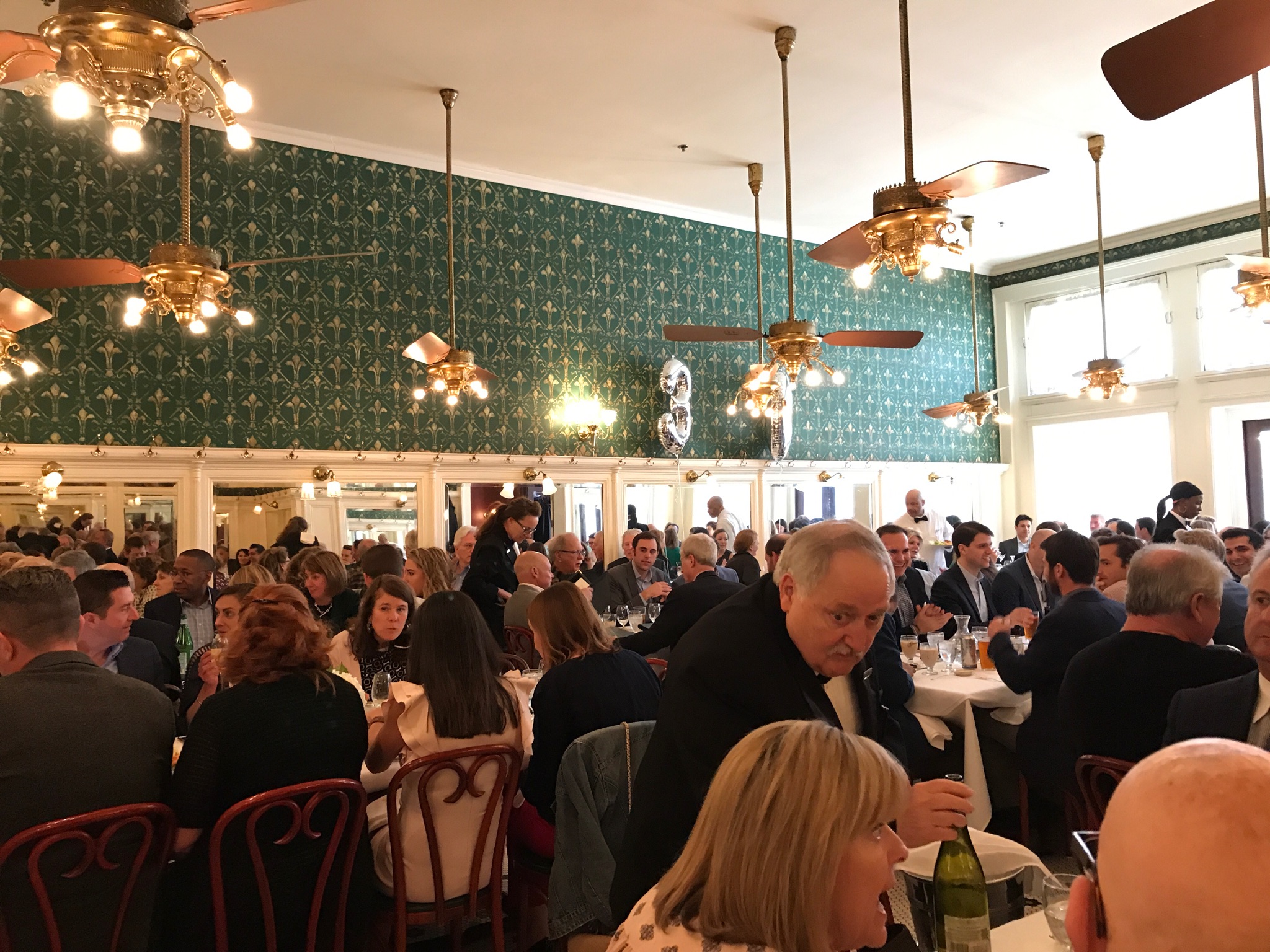4 Hours, 3 Cocktails, 2 Desserts, 1 of a Kind Experience
Photo: Central City Millworks (they did all off the millwork for remodel in 2012)
Having lived in New Orleans for several years in my mid-20s, I indulged in many of the unique experiences that the city has to offer. When I knew that I would be relocating for work, I made a bucket list of all the restaurants that I wanted to visit before my impending move. One meal that I was unable to cross off my list was Friday Lunch at Galatoire’s. Upon learning that my wife would be traveling to New Orleans for a conference, I decided to tag along and try to get a seat at the table.
Getting a Seat at the table
While most popular restaurants in New Orleans require a reservation, Friday lunch at Galatoire’s is the exception. Tables in the first-floor dining room are reserved on a first-come, first-served basis. A staff member will appear outside the restaurant door around 8am and will begin taking names for the 11:30 seating. With only 41 tables and 132 seats, the list fills up between 8:30-10am on most Fridays (notable exceptions: the Fridays before Mardi Gras and Halloween when tables are auctioned off for charity.) There are also professional line sitters that will show up early and put your name on a list for a fee. For those who are unable to get a seat during the 11:30 seating, there is a second seating following this (whenever tables open up) and reservations may be made for the upstairs dining room. However, my local friends stressed the importance of eating downstairs with the first seating to really get the full experience.
Unfortunately, I underestimated the impact of the line sitters and did not get to the restaurant until 8:45am. By the time I reached the front of the line, the list for the first seating downstairs was full, and the host was taking names for the upstairs dining room. So after the crowd dispersed, I went into the restaurant to see if I could grease some palms to get my name on the list. The host declined my gratuity but offered to put my name on the list for the second seating. He instructed me to return around 1:30 and hopefully we’d get seated around 2pm. Seeing that this was my next best option, I put my name on the list and left the restaurant.
I cursed myself for staying out too late the night before and texted my wife the disappointing news. She walked over from the conference early anyway to kill time while we waited for our table. After we had made it only a few blocks, I received a text from the restaurant that our table was ready just a few minutes after noon. We raced back to restaurant and the host informed us a table no-showed and that we were the next duo on the list. As the second to last table seated, and having defied the odds of getting a seat without paying a line sitter, we walked into a packed dining room and eagerly awaited our turn at the Friday Lunch experience.
Packed Dining Room taken during our lunch
The Ambiance
The best words to describe the temperment of the room are jovial and energized. With patrons dressed in their Sunday best, multiple tables with large birthday balloons floating above, and a large table of rowdy groomsmen helping send off an expectant groom, everyone in the dining room appeared to be celebrating something. Throughout the meal, servers would clang glasses to get the restaurant’s attention so that everyone could participate in celebratory birthday toasts and singing "Happy Birthday." The entire dining room participated with the same enthusiasm for each toast as if it were for one of their tablemates. People were up and about tablehopping, drink in tow, saying hello and catching up with friends who serendipitously happened to be at Galatoire’s as well as visiting with strangers.
It was impressive to watch the staff navigate through the chaos. They had an unbelievable knack of appearing when needed then disappearing to let you enjoy your meal. Plates were cleared as soon as the last bites were finished, and new drink orders were taken as soon as glass bottoms were raised for the last sip.
With tables placed closely together, you cannot help but interact with the neighboring tables. We quickly learned that the table next to us consisted of a middle-aged couple treating their college age daughter and her boyfriend to lunch to commemorate the boyfriend’s first trip to the Crescent City. They were regulars at Galatoire’s and wanted their daughter’s boyfriend to have a quintessential New Orleans experience. When they asked what we were celebrating, I told them about my bucket list and not getting to cross it off during my time living here. They welcomed me back to the city and informed us that we were in for a treat. My wife mentioned that she was here for a conference and that, if we had to celebrate something, she had celebrated a birthday last week. After discovering we were from out of town, they proceeded to inquire about all the places we had eaten and the sights we'd taken in during the week. We also traded suggestions of books to read, places to eat around town and made friendly conversation. The only breaks in the conversation were the birthday toasts and eating as the food arrived. However, the conversation would pick back up between courses. At one point during the meal, the wife snuck off to tell our waitress about my wife's recent birthday so that she could also get her own birthday toast. They were our de facto tour guides for the duration of the meal and definitely enhanced our dining experience. We ended the meal by exchanging emails and well wishes.
While my wife and I enjoy a good meal, neither of us are very familiar with traditional French Creole cuisine. However, we are generally adventurous eaters and enjoy sharing so we get to try everything on the table. Luckily, the table next to us told us close our menus and let our waitress guide us through the meal. Our server, Martine, quickly appeared and took our first drink order. When she returned, she recommended we start off with the soufflé potatoes and the Galatoire Goute (pronounced goo-tay), which consisted of shrimp remoulade, Crabmeat Maison and a crawfish salad. She instructed us to either dip the potatoes in hollandaise sauce or to stuff the potatoes with the Goute.
Next, we ordered our second round of cocktails and proceeded with the duck and andouille (pronounced an-doo-ee) gumbo and the iceberg wedge salad with apple smoked bacon that was sweet enough to have been candied.
After letting our food digest and enjoying our cocktails, our server returned to take our order for the main entrees. After telling Martine that we wanted both a fish and a meat entrée, she suggested that we order the redfish with the crabmeat Yvonne garnish and the petite filet cooked medium rare with béarnaise garnish. For sides, she recommended the cream spinach and asparagus hollandaise. We ordered our third cocktail and eagerly awaited out meal. When our entrees arrived, Martine had noticed that we had been trading plates mid-course and had the entrees split in half before arriving at the table.
Redfish with Crab Yvonne and Medium Rare Petite Filet with béarnaise garnish
As a self-proclaimed bread pudding aficionado, I was looking forward to trying the house bread pudding with their banana praline sauce. My wife was also eyeing the black bottom pecan pie with an oreo crust and whiskey caramel sauce. After consulting Martine, we ordered both. Our new friends at the table next to us also recommended that we try the café brûlot (pronounced bru-low) which he described as a brandy spiced coffee drink that is set on fire. With an endorsement like that, we were unable to say no. Both desserts were delicious, but we both agreed the pecan pie was the superior dish.
Left: Black Bottom Pecan Pie Right: Bread Pudding with Banana Praline sauce
While neither my wife nor I routinely order cocktails with lunch, we decided that Friday Lunch at Galatoire's would be an exception. I started off with the Kentucky Reserve which consisted of Woodford bourbon, tuaca liqueur, Angostura bitters and a brandied cherry served up in classic coupe glass. The drink was well balanced with a boozy base and a sweet finish. My wife’s first round was the Old Fashion, which was made in the classic style, with bourbon, Peychaud’s bitters, house made simple syrup, orange and a maraschino cherry in a rocks glass.
My wife with her Old Fashion and my Kentucty Reserve in the coupe glass
My wife’s next round was the Galatoire’s Milk Punch, which consisted of bourbon, milk, vanilla, simple syrup, and nutmeg. It honestly tasted like a boozy milkshake. I went for the Galatoire’s Specialty Cocktail which was essentially a Sazerac with bourbon instead of rye whiskey.
For round three, I ordered a Sazerac which was made up of rye whiskey, Herbsaint, Peychaud’s bitters, simple syrup and a lemon twist. My wife, who was warming up her palate for dessert, went with the house’s take on the Classic Daiquiri. They used Louisiana’s own Rougaroux Sugarshine Rum, lime juice, simple syrup, lime, shaken and served it neat. The 101-proof rum with the lime juice gave the drink a kick and acidic bite that made the drink much more palatable than the sweeter versions of the drink I have previously encountered.
Farewell
After eating an incredible meal, imbibing in delicious cocktails and saying farewell to our new friends that we made over the past four hours, we settled up with our server (after taking a selfie together) and made our way out of the restaurant. While I had high expectations for our Friday Lunch at Galatoire’s, the experience exceeded them all. People often say that outside of New Orleans, Mardi Gras is just another Tuesday, I think the same sentiment can be applied to Friday lunches not at Galatoire's.
Lagniappe: While waiting in line, I chatted up some of the hired line sitters and got a phone number that I can use the next time I want to eat at Galatoire’s. Contact me and I will share the contact information.






